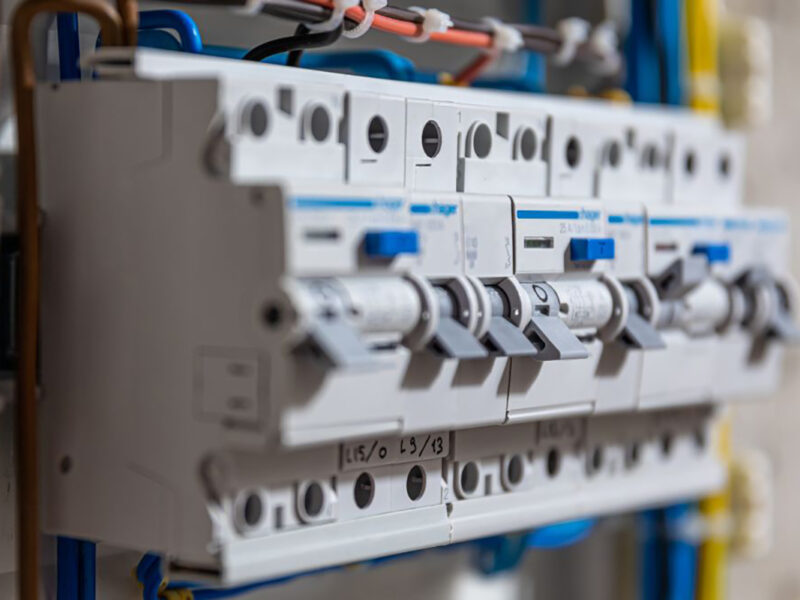
Circuit Breaker: Introduction
A circuit breaker is an essential safety device in electrical systems, designed to protect circuits from damage caused by overcurrent, short circuits, and other electrical faults. Unlike fuses, which need replacement after a fault, circuit breakers can be reset, offering a more convenient and cost-effective solution for maintaining electrical safety.
Circuit Breaker: Importance in Modern Electrical Systems
Circuit breakers play a pivotal role in ensuring the safety and reliability of electrical systems. Their primary functions include:
-
Overload Protection: Preventing circuits from carrying more current than they are designed for, which can cause overheating and potential fires.
-
Short Circuit Protection: Interrupting the flow of electricity when a fault causes current to take an unintended path.
-
Ground Fault Protection: Detecting and stopping current leakage to the ground, which can be hazardous.
By automatically disconnecting power during abnormal conditions, circuit breakers help prevent equipment damage, electrical fires, and personal injuries.
Circuit Breaker: Types and Classifications
Circuit Breaker by Voltage Level
-
Low Voltage Circuit Breakers (LV): Used in residential and commercial applications, typically handling voltages up to 1,000V.
-
Medium Voltage Circuit Breakers (MV): Suitable for voltages ranging from 1,000V to 72,500V, commonly found in industrial settings.
-
High Voltage Circuit Breakers (HV): Designed for voltages above 72,500V, used in power transmission and distribution networks.
Circuit Breaker by Interruption Mechanism
-
Air Circuit Breaker (ACB): Uses air as the arc extinguishing medium, suitable for low voltage applications.
-
Vacuum Circuit Breaker (VCB): Employs a vacuum to extinguish the arc, ideal for medium voltage systems.
-
SF6 Circuit Breaker: Utilizes sulfur hexafluoride gas for arc extinction, common in high voltage applications.
-
Oil Circuit Breaker: Uses oil to quench the arc, though less common due to environmental concerns.
Circuit Breaker by Installation Environment
-
Indoor Circuit Breakers: Installed within buildings, protected from environmental factors.
-
Outdoor Circuit Breakers: Built to withstand external conditions like temperature variations and moisture.
Circuit Breaker by Operation Mechanism
-
Manual Circuit Breakers: Require human intervention to reset after tripping.
-
Automatic Circuit Breakers: Reset automatically after a fault is cleared.
Circuit Breaker by Number of Poles
-
Single-Pole: Controls one circuit, commonly used in residential applications.
-
Double-Pole: Controls two circuits simultaneously, suitable for 240V appliances.
-
Three-Pole: Manages three-phase systems, typical in industrial settings.
-
Four-Pole: Includes a neutral pole, used in complex electrical systems requiring neutral isolation.

Circuit Breaker: Common Causes of Tripping
Understanding why a circuit breaker trips is crucial for maintaining electrical safety:
-
Overloaded Circuits: Occurs when too many devices draw power from the same circuit, exceeding its capacity.
-
Short Circuits: Happens when a hot wire touches a neutral or another hot wire, causing a surge of current.
-
Ground Faults: Arises when a hot wire contacts a grounded surface, leading to unintended current flow.
-
Faulty Appliances: Defective devices can draw excessive current, triggering the breaker.
-
Aging or Damaged Breakers: Over time, breakers can wear out and trip unnecessarily.
Circuit Breaker: Replacement Guidelines
Replacing a circuit breaker involves several steps:
-
Turn Off Power: Ensure the main power supply is switched off.
-
Remove Panel Cover: Access the breaker panel by removing its cover.
-
Identify Faulty Breaker: Locate the breaker that needs replacement.
-
Disconnect Wires: Carefully detach wires connected to the faulty breaker.
-
Install New Breaker: Connect wires to the new breaker and secure it in place.
-
Restore Power: Replace the panel cover and turn the power back on.
Note: It’s recommended to hire a licensed electrician for breaker replacement to ensure safety and compliance with local codes.

Circuit Breaker: Conclusion
Circuit breakers are vital components in electrical systems, safeguarding against potential hazards by interrupting power during faults. Understanding their types, functions, and maintenance can help ensure a safe and efficient electrical environment.
Professiona Switchgear supplier and manufacturer
- Zhejiang GONGSHUN Electrical Co.,Ltd (electricgs.com), Our company was founded in the late 1990s, specializing in the production of inflatable cabinets, SF6 inflatable cabinets, and various high and low voltage complete sets of electrical equipment. It has multiple subsidiaries under its jurisdiction, including high-voltage load switch branch, high-voltage circuit breaker branch, high-voltage fuse branch, and technology development branch.Our technical expertise, comprehensive product portfolio and long-term rich experience are helping many customers in need to solve their power problems. We’re happy to help at any time. Whether you need application product advice or technical assistance, our global service team is committed to providing you with the right support. For more technical information about medium voltage earthing switch, feel free to contact us, send an email to gongshun@electric-cn.com
- Our company specializes in producing 12KV-40.5KV series high-voltage electrical products: FZN58, FLN48, FLN36, FZRN25, FZN21, FN18, ZFN16, FN12, FN8, FN7, FN5, XRNT, XRNP, VS1, ZN28, ZW8, ZW32, JN15, GN19, GN22, GN24, GN30, CLXGN15-12, HXGN □ -12, DXG-12 (L), DFW □ -12 high-voltage cable branch box, CLXGN □ -12 (SF6) series inflatable cabinet 12KV and 35KV cable accessories, etc; CLVXP-12 indoor AC high voltage fixed switchgear, CL-SIS-12 compact solid insulated ring main unit, professional assembly Schneider SC6 (SF6) series load switchgear, ABB produced SFG (SF6) series load switchgear and other series products; Distribution and agency of high-voltage load switches and inflatable cabinets produced by Schneider Electric and ABB; Siemens produces the 3AJ1 series of indoor medium voltage vacuum circuit breakers and other related products. The company has a complete range of products and has been operating safely on domestic and international power grids for a long time, receiving unanimous praise from both new and old users. Among them, multiple products such as FZRN25, FN12, FLN36-12, XRNT-12 have been exported to various countries and regions in East Asia, South Asia, Southeast Asia, Africa, and the United States.
